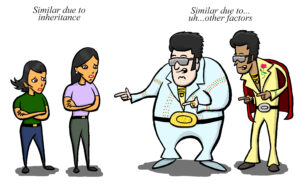Understanding homology and convergent evolution
by the Understanding Evolution team
In everyday life, people look like one another for different reasons. Two sisters, for example, might look alike because they both inherited brown eyes and black hair from their father. On the other hand, two people attending an Elvis impersonators’ convention may look alike because they are both wearing rhinestone studded suits and long sideburns. The similarity between the sisters is inherited, but the similarity between the Elvis impersonators is not.

Biological similarity
It works the same way in evolution. Some traits shared by two living things were inherited from their ancestor, some similarities evolved in other ways – and of course, some similarities did not evolve at all (like two plants that both grow tall because they got the right combination of sun and water). Similarities explained by inheritance of that trait from a common ancestor are called homologies.
In this module, you’ll learn more about homologies and why they are important. We’ll start by playing a game to get you thinking about similarities and differences.
homology
traits inherited by two different organisms from a common ancestor
convergent evolution
process in which two distinct lineages evolve a similar characteristic independently of one another
